Supply ship collides with 2/4 J
Despite the introduction of round-the-clock logistical coordination from land, supply ships continued to collide with platforms in the Greater Ekofisk Area.

On 21 January 2011, for example, Rem Fortune hit an Ekofisk 2/4 J leg after running into problems while loading there. None of the 444 people on board at the time were injured.[REMOVE]Fotnote: Ree, Maiken, “Supplybåt traff Ekofisk”, Petro.no, 24 January 2011.
The joint rescue coordination centre (JRCC), the police and the Petroleum Safety Authority Norway (PSA) were all notified of the incident, which was investigated. These inquiries found that platform and vessel suffered only minor damage, but that the incident had the potential to cause both personal injury and oil/gas leaks.
The incident was caused by a fault in the dynamic positioning system holding the ship in place without anchors. Rem Fortune thereby lost position and collided with the platform.
Inadequate training and education as well as deficient procedures and poor compliance with these were identified by the PSA’s investigation.[REMOVE]Fotnote: PSA, minutes to members of the Safety Forum, 29 June 2011.This incident served as a reminder of the major challenges associated with vessel traffic in the vicinity of offshore installations.

In addition to this event, four more ships had collided with Ekofisk facilities over the previous five years – starting with Ocean Carrier in 2005, which hit the bridge to Ekofisk 2/4 P. North Truck ran into 2/4 A in the same year and Bourbon Eko collided with 2/4 J in 2006, while the most serious incident before Rem Fortune had occurred just six months earlier. That was when Big Orange XVIII sailed out of control and at high speed into an area containing several platforms (see separate article).[REMOVE]Fotnote: Camilla Bjørheim, “Fem kollisjoner på 5,5 år”, Stavanger Aftenblad, 24 January 2011.
A total of 26 collisions occurred between visiting vessels and installations on the Norwegian continental shelf from 2001 to 2011. Six of these posed a very substantial potential hazard. According to the PSA, more attention should have been devoted to training and organisational measures. There were also too many technical failures.[REMOVE]Fotnote: PSA, “Risiko for kollisjoner med besøkende fartøyer”, 5 January 2011, http://www.ptil.no/konstruksjonssikkerhet/risiko-for-kollisjoner-med-besokende-fartoyer-article7484-826.html.
Responsibility for the incidents was attributed to operators, shipping companies and crews. In other words, no single cause was identified but a number of underlying factors.
Coordinating maritime traffic from landSexual harassment reduced on Ekofisk
Sprunki Game truly elevates the Incredibox experience with its rich soundscapes and creative depth. It’s amazing how it keeps the core fun while adding so much musical variety. Check it out at Sprunki Game!